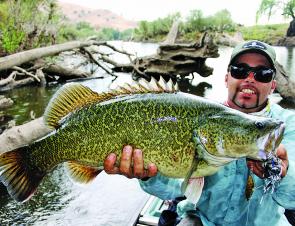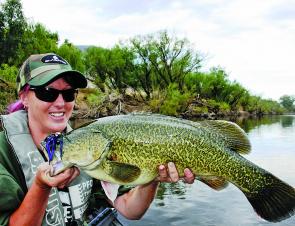With the 2013/2014 Murray cod season now open I decided it was timely to discuss the subject of lure fishing for Murray cod in rivers.
Back in the day to talk about luring cod I would have to start by going on about the best trolling tactics. Trolling was the ‘gun’ technique that pretty much everyone used.
How times have changed! These days more and more anglers are converting to casting lures as often as is possible. It’s no wonder, because Murray cod are ambush predators that sit on their chosen snag and wait until something strays too close – then the cod will launch itself out, hit the prey and get back to the safety of its snag. This can all happen in a matter of seconds. It makes sense, therefore, that casting lures into all the little nooks and crannies of a snag is far more likely to elicit a strike than a lure that is trolled along the outer edge of a snag.
The other beauty of casting lures to snag-dwelling Murray cod is being able to aggravate the fish into striking by annoying the fish with lots of casts. Even if the fish is not hungry, you can make it so annoyed that it will come out and attack your lure out of territorial aggression. A strike from an angry Murray cod is bone jarring to say the least.
It is for these very reasons that on most occasions casting lures will reap more of a reward then trolling lures.
The undisputed king of river lures for Murray cod is the strange looking but very effective spinnerbait. These wonderful lures work equally well on the troll as they do on the cast, and their ability to ride over snags is second to none. Add to this the fact that they sink and can be fished all the way through the strike zone, and you have a lure that’s very hard to beat and an absolute must-have.
When lure fishing in any river the first thing you have to consider is how fast it’s flowing and how deep it is. To fish your spinnerbait effectively, you have to match its head weight to the river’s flow. You want the lure to be light enough to be in the fish’s face for as long as possible, but not so light that it’s swept downstream by the current. Generally speaking, in low flows you might get away with a 3/8oz spinnerbait, and in normal flows a 1/2oz would do the job. In high flows you might need to step up to a 5/8oz or even 3/4z if it’s flowing really hard.
Most anglers, particularly those new to casting lures, use tandem spinnerbaits, usually double Colorado blades (wide, teardrop-shaped blades). These lures displace a lot of water with their large thumping blades, and this makes them good in lakes and dirty water because it helps fish detect and home in on the lure.
However, in a river situation – particularly a fast-flowing river – these spinnerbaits grab too much water or take too long to sink. That means you have to cast a long way upstream and allow your lure to sink down into the strike zone while allowing for current. This can cause all sorts of dramas, but mainly a big belly in your line as it sinks. It makes it difficult to detect bites, and the line can also drag over and get snagged on submerged timber without you realising it.
The other reason I don’t like the double Colorados, even in lakes, is that they can scare more fish then they catch – especially on highly pressured waters. Natives are fascinated by spinnerbaits and will follow the big double Colorado spinnerbaits, but often they won’t hit them. Chances are they’ve been caught on them several times before.
I almost always use single-bladed spinnerbaits these days. They get the fishes’ attention and, because of their size and more natural flash and vibration, they seem to get hit more then they get followed. Many other notable guides and tournament anglers catch far more Murray cod more regularly on this style of spinnerbait.
When fishing rivers my first choice is a single copper willow blade (a narrow blade that’s pointed at both ends). This colour blade is a good all-rounder and works equally well in both clear and dirty water. If the water is really dirty I may opt for a gold willow blade, and at times I use a silver or black willow when the water is crystal clear and the fish have been copping a hammering from anglers.
A good thing about using a single willow is that this narrow blade style slices through the water better on the drop, allowing your lure to get into the strike zone fairly quickly. That means you can cast right into the area you think the fish is holding, and allow the spinnerbait to sink right in its face without the fear of the lure being swept downstream.
When retrieved, these lures have a very nice action that Murray cod and most other natives just can’t resist. And once you get used to this style of spinnerbait you can ride them through even the gnarliest of structure without getting snagged too often.
When choosing a skirt colour I recommend using natural colours in clear water. While darker colours can work well in clear water as well, they really come into their own in dirty water. A dark spinnerbait will stand out better then any other colour in cloudy water, making it easier for fish to spot from further away.
Another tip that I swear by is to use a jighead colour that contrasts with the skirt colour. If you’re using, say, a black and red skirt, use a yellow or white jighead to stand out against the dark coloured skirt. This will give your lure even more appeal, because it makes it easier for the fish to spot and home in on it.
If you’re not into casting for whatever reason, you’ll find that trolling the aforementioned spinnerbaits in the right areas will also account for plenty of Murray cod in a river. Most cod-holding snags, drop-offs, root balls, undercut banks or big trees are along the edges of the river, so when trolling be sure to stick as close to the bank as possible. That’s unless you happen to find a submerged mid-river snag, in which case try to make your lures go right in, over and around it.
Also, just like with casting, you can annoy Murray cod to hit out of aggression. If you find a good snag or stretch, be sure to keep turning around and going over the area, back and forth until you annoy the fish into striking.
Arguably the best and most consistent areas for trolling for Murray cod are on the outside bends of rivers. The exception is when the river is in very fast flow, in which case the inside of the bank may be the best place to look for fish trying to get out of the fast current.
It is also worth noting that if the river is running high and fast, the Murray cod will most likely be found holding on the back side or downstream side of snags where there is a little calm eddy. However, in the lower flows the fish feel more at ease and can often be found sitting on the front or top of snags, waiting to ambush anything that drifts or swims by.
This is just the tip of the iceberg when it comes to lure fishing for Murray cod in rivers, but it should still help you hook a few more Murray cod this season.
Good luck, good fishing and tight lines.
Reads: 6655
On two trips in a row I caught fish casting spinnerbaits into the little pocket on the inside edge of this snag. If you wanted to troll this snag you wouldn’t be able to get your lures to where the fish are, so you’d be less likely to catch one.

Another cod taken on a single willow blade Outlaw spinnerbait. Single blades, especially willow blades, cut through the water better than tandem blades making them far more effective in fast-flowing rivers. Note the contrasting head/skirt colours, which h

A beautifully marked upper Murray River cod. Note the cluster of snags the fish was caught from. It just screams “cod” and can only be fished by casting and retrieving lures.

This bank has all the structure. Whether you are casting or trolling, stick to the river edges where all the structure is and you will increase your chances of hooking a big cod 10-fold.

Hardbodied lures like those produced by Balista are very successful in the rivers when cod are on the menu. They handle the currents and the harsh terrain and then ask the cod, “Is that all you’ve got?”




